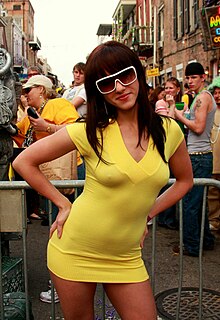Juliana's, also known as Juliana's Tokyo (ジュリアナ東京), was a Japanese discothèque that operated in Shibaura, Minato, Tokyo[1] from May 15, 1991 till August 31, 1994.[2] It was famous for its dance platforms, on which office ladies dressed in "bodycon" (abbr. (wasei-eigo): "body conscious" (ボディコン, bodikon, "sexually flattering clothing")[3][4]) clubwear would congregate, as amateur go-go dancers (professionals were also employed).[5] The club was produced by Masahiro Origuchi[6][7] for the British leisure services group Juliana's (led at the time by Michael Wilkings and Mark Vlassopulos), and Nissho Iwai Corporation, the Japanese general trading company (now part of Sojitz).[8]


Musical style and legacy
editJuliana's started out playing Italo house then quickly following popular trends to Hardcore techno. The Juliana's producers published a series of compilation CDs which were popularizing techno in Japan. The album sales were an essential part of the business concept along with contracting with sponsors led by VP of marketing Reef Addison and Juliana's President Gary Calicott.
Cultural impact
editAt any given moment Juliana's was packed at 2,500 customers and a line so long you couldn't see around the block. The Juliana culture represented a hedonistic youth culture which had only recently arrived in Japan. The gyaru subculture found its expression in high school girls and office ladies alike transforming into Juliana girls in the evening, whereas men often came to the club in business suits.
References
editThe club "Disco Queen" in chapters 18, 19, and 21 of the rugby manga No Side[9] by Ikeda Fumiharu (池田文春)[10] is a reference to Juliana's, down to the white feather fans used by the dancers.[11]
The club Juliana's is mentioned several times in the shōjo manga Hana Yori Dango by Yoko Kamio (神尾 葉子).
Earthquake Bird movie has club scenes heavily influenced by Juliana's and bodycon fashion styles.[12]
See also
edit- Herve Leger—the fashion house founded by the creator of the body-con dress
Notes
edit- ^ Brand, Tokyo Night City, p. 34.
- ^ Avex Trax, Forever Juliana's Tokyo - The Last Night of Juliana's Tokyo, YouTube
- ^ Jim Breen's WWWJDIC, ボディコン Archived 2012-06-30 at archive.today.
- ^ Chaplin, Sarah. Japanese Love Hotels: A Cultural History. Routledge contemporary Japan series, 15. London: Routledge, 2007, p. 135. ISBN 978-0-415-41585-9, ISBN 978-0-203-96242-8.
- ^ Schilling, Mark (1997). The Encyclopedia of Japanese Pop Culture. Weatherhill. pp. 76–78. ISBN 0-8348-0380-1.
- ^ Kawakami, "Survivors: two approaches to survival in Japan's unkind economy".
- ^ Trends in Japan, "Disco Icon Sets Out To Conquer Nursing Care".
- ^ Schilling, The Encyclopedia of Japanese Pop Culture, p.77.
- ^ ノーサイド (No Side, ("Nō Saido")) volume 3, pp. 32–3, 35, 66–68, 111–123. ISBN 4-08-875070-5.
- ^ PRISMS: The Ultimate Manga Guide, No Side. Accessed 10 August 2008.
- ^ Fujino, Chiya. "Her Room". In Ozeki, Ruth, and Cathy Layne. Inside and Other Short Fiction: Japanese Women by Japanese Women; with a foreword by Ruth Ozeki; compiled by Cathy Layne, p. 144. Tokyo: Kodansha International, 2006. ISBN 4-7700-3006-1. Accessed 10 August 2008.
- ^ "How 1980s Japan Became History's Wildest Party | Earthquake Bird | Netflix - YouTube". www.youtube.com. Retrieved 2021-02-14.
References
edit- Associated Press. "Juliana's craze ceases", September 1, 1994. Accessed 2 July 2017.
- Brand, Jude. Tokyo Night City. Rutland, Vermont: Charles E. Tuttle Company, 1993. ISBN 0-8048-1896-7.
- Kawakami, Sumie. "Survivors: two approaches to survival in Japan's unkind economy: meet the fighter and the surfer - H.I.S. president Hideo Sawada and Goodwill Group CEO Masahiro Origuchi". Japan, Inc., December 2002. Accessed 10 August 2008.
- Schilling, Mark. "Juliana's" in The Encyclopedia of Japanese Pop Culture. New York: Weatherhill, 1997. ISBN 0-8348-0380-1.
- Sterngold, James. "A Night on the Town in Tokyo". The New York Times, October 18, 1992. Accessed 2 July 2017.
- Trends in Japan. "Disco Icon Sets Out To Conquer Nursing Care: Former Club Producer Ventures Into New Territory", June 30, 2000. Accessed 10 August 2008.